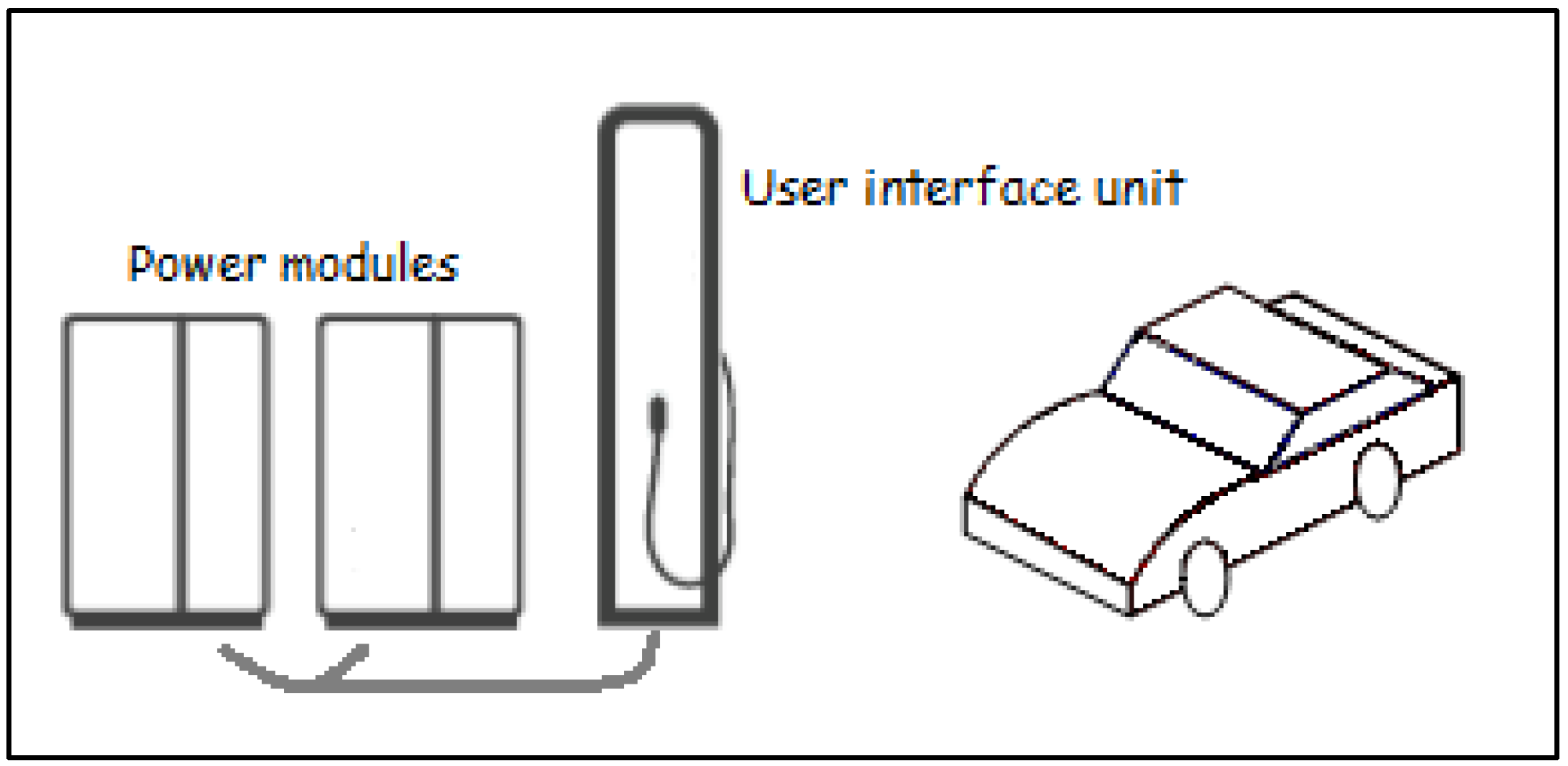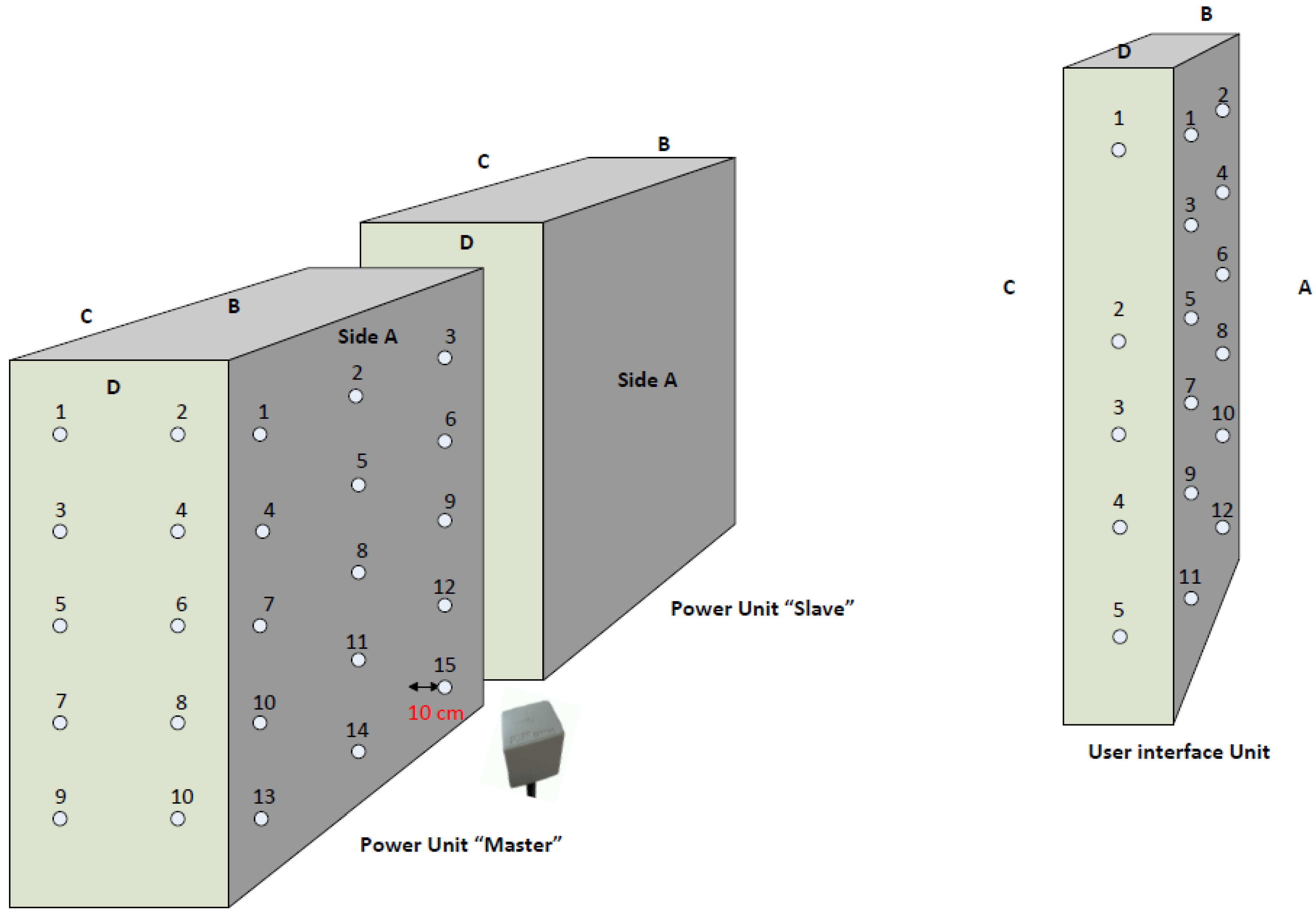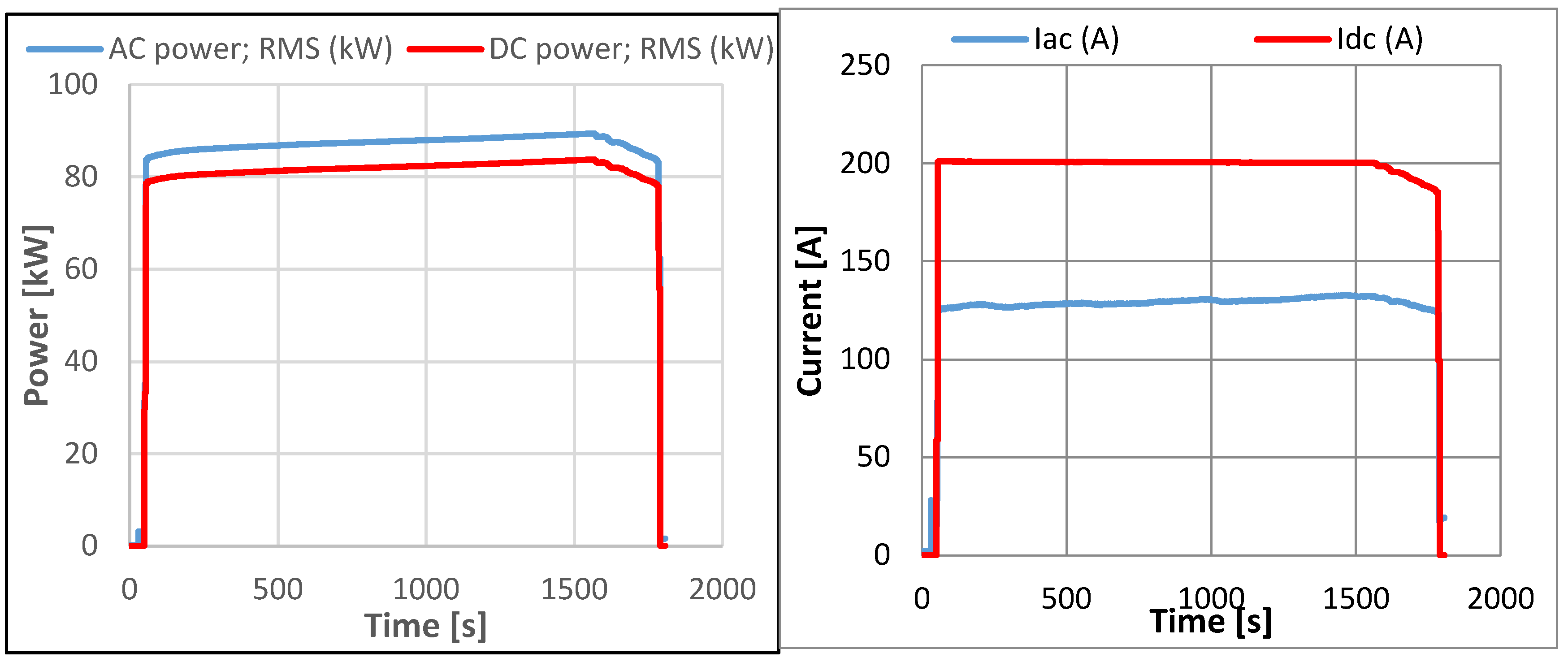Low Frequency Magnetic Fields Emitted by High-Power Charging Systems
Abstract
1. Introduction
2. Materials and Methods
3. Results
4. Conclusions
Author Contributions
Funding
Acknowledgments
Conflicts of Interest
References
- Spöttle, M.; Jörling, K.; Schimmel, M.; Staats, M.; Grizzel, L.; Jerram, L.; Drier, W.; Gartner, J. Research for TRAN Committee—Charging Infrastructure for Electric Road Vehicles; Policy Department for Structural and Cohesion Policies: Brussels, Belgium, 2018. [Google Scholar]
- European Commission (EC). 1999/519/EC Council recommendation of 12 July 1999 on the limitation of exposure of the general public to electromagnetic fields (0 Hz to 300 GHz). Off. J. Eur. Communities 1999, 199, 59–70. [Google Scholar]
- International Commission on Non-Ionizing Radiation Protection (ICNIRP). Guidelines for limiting exposure to time varying electric, magnetic and electromagnetic fields (up to 300 GHz). Health Phys. 1998, 74, 494–522. [Google Scholar]
- Samaras, T.; Leitgeb, N.; Auvinen, A.; Danker-Hopf, H.; Mattsso, M.-O.; Norppa, H.; Rubin, G.J.; Scarfí, M.R.; Schüz, J.; Sienkiewicz, Z.; et al. SCENIHR (Scientific Committee on Emerging and Newly Identified Health Risks), Potential Health Effects of Exposure to Electromagnetic Fields (EMF), 27 January, 2015; European Commission DG SANTE: Luxembourg, 2015. [Google Scholar]
- World Health Organization (WHO). Environmental Health Criteria 238: Extremely Low Frequency Fields; WHO: Geneva, Switzerland, 2007. [Google Scholar]
- Repacholi, M. Concern that “EMF” magnetic fields from power lines cause cancer. Sci. Total. Environ. 2012, 426, 454–458. [Google Scholar] [CrossRef] [PubMed]
- Trentadue, G.; Pinto, R.; Salvetti, M.; Zanni, M.; Pliakostathis, K.; Scholz, H.; Martini, G. Assessment of Low-Frequency Magnetic Fields Emitted by DC Fast Charging Columns. Bioelectromagnetics 2020. [Google Scholar] [CrossRef] [PubMed]
- International Electrotechnical Commission (IEC). IEC 61851-23 Electric Vehicle Conductive Charging System—Part 23: DC Electric Vehicle Charging Station; IEC: Geneva, Switzerland, 2014. [Google Scholar]
- International Commission on Non-Ionizing Radiation Protection (ICNIRP). Guidelines for limiting exposure to time-varying electric and magnetic fields (1 Hz TO 100 kHz). Health Phys. 2010, 99, 818–836. [Google Scholar]
- European Union (EU). Directive 2013/35/EU of the European Parliament and of the Council of 26 June 2013 on the minimum health and safety requirements regarding the exposure of workers to the risks arising from physical agents (electromagnetic fields). Off. J. Eur. Union 2013, 2013, 1–21. [Google Scholar]
- International Commission on Non-Ionizing Radiation Protection (ICNIRP). Guidance on determining compliance of exposure to pulsed fields and complex non-sinusoidal waveforms below 100 kHz with ICNIRP guidelines. Health Phys. 2003, 84, 383–387. [Google Scholar] [CrossRef] [PubMed]
- Crotti, G.; Giordano, D. Analysis of critical situations in the evaluation of human exposure to magnetic fields with complex waveforms. Radiat. Prot. Dosim. 2009, 137, 227–230. [Google Scholar] [CrossRef] [PubMed]
- Hareuveny, R.; Sudan, M.; Halgamuge, M.N.; Yaffe, Y.; Tzabari, Y.; Namir, D.; Kheifets, L.I. Characterization of Extremely Low Frequency Magnetic Fields from Diesel, Gasoline and Hybrid Cars under Controlled Conditions. Int. J. Environ. Res. Public Health 2015, 12, 1651–1666. [Google Scholar] [CrossRef] [PubMed]
- Karabetsos, E.; Kalampaliki, E.; Koutounidis, D. Testing Hybrid Technology Cars: Static and Extremely Low-Frequency Magnetic Field Measurements. IEEE Veh. Technol. Mag. 2014, 9, 34–39. [Google Scholar] [CrossRef]
- Concha, P.M.-T.; Velez, P.; Lafoz, M.; Arribas, J.R.; Moreno-Torres, P. Passenger Exposure to Magnetic Fields due to the Batteries of an Electric Vehicle. IEEE Trans. Veh. Technol. 2015, 65, 4564–4571. [Google Scholar] [CrossRef]
- Tell, R.A.; Sias, G.; Smith, J.; Sahl, J.; Kavet, R. ELF magnetic fields in electric and gasoline-powered vehicles. Bioelectromagnetics 2012, 34, 156–161. [Google Scholar] [CrossRef] [PubMed]
- Vassilev, A.; Ferber, A.; Wehrmann, C.; Pinaud, O.; Schilling, M.; Ruddle, A.R. Magnetic Field Exposure Assessment in Electric Vehicles. IEEE Trans. Electromagn. Compat. 2014, 57, 35–43. [Google Scholar] [CrossRef]
- Carlson, R.; Normann, B. Test results of the PLUGLESSTM inductive charging system from Evatran Group, Inc. SAE Int. J. Altern. Powertrains 2014, 3, 64–71. [Google Scholar] [CrossRef]
- Campi, T.; Cruciani, S.; Maradei, F.; Feliziani, M. Magnetic Field during Wireless Charging in an Electric Vehicle According to Standard SAE J2954. Energies 2019, 12, 1795. [Google Scholar] [CrossRef]
- International Electrotechnical Commission (IEC). IEC 61786-1 Measurement of DC Magnetic, AC Magnetic, and AC Electric Fields from 1 Hz to 100 kHzwith Regard to Exposure of Human Beings—Part 1: Requirements for Measuring Instruments; IEC: Geneva, Switzerland, 2013. [Google Scholar]
- Narda Safety Test Solutions. User’s Manual EHP-50G Electric and Magnetic Field Probe—Analyzer from 1 Hz up to 400 kHz; Narda Safety Test Solutions: Segrate, Italy, 2016. [Google Scholar]



| HPCSs | Electrical Specifications | Efficiency and Power Factor | Weight and Dimensions (W × D × H) | Operating Temperatures |
|---|---|---|---|---|
| 1 | 400 Vac ± 10%, 50 Hz, 277 A nominal @ 400 Vac, (160 kW); DC output: 500 A, 150–920 V (up to 350 kW) | ≥94% at full load PF ≥ 0.97 | 2 power cabinets (1340 kg, 2030 × 1170 × 770 mm3) + User interface unit (250 kg, 2390 × 620 × 440 mm3) | −35 °C to + 55 °C |
| 2 | 400 Vac ± 10%, 50 Hz 248 A @ 172 kVA; DC output: 500 A up to 640 V; nominal power 322 kW @ 920 V | >95% @ full power PF: 0.98 | 2 power cabinets (1100 kg, 1000 × 800 × 1800 mm3) + User interface unit (260 kg, 600 × 300 × 2400 mm3) | −25 to + 50 °C/−35 °C to + 50 °C (cold option) |
| Side | A | B | C | D | ||||
|---|---|---|---|---|---|---|---|---|
| Positions | B (μT) Wide Band | EI % | B (μT) Wide Band | EI % | B (μT) Wide Band | EI % | B (μT) Wide Band | EI % |
| 1 | 3.40 | 19.86 | 4.56 | 36.06 | 4.64 | 21.10 | 4.21 | 13.84 |
| 2 | 3.35 | 19.22 | 5.78 | 40.31 | 4.46 | 19.93 | 4.38 | 12.96 |
| 3 | 4.10 | 22.74 | 8.41 | 57.81 | 4.68 | 23.78 | 8.96 | 26.21 |
| 4 | 7.11 | 36.05 | 12.99 | 77.62 | 14.45 | 59.23 | 9.51 | 25.89 |
| 5 | 6.31 | 38.55 | 23.03 | 121.6 | 12.50 | 46.64 | 20.91 | 61.15 |
| 6 | 7.79 | 42.43 | 46.26 | 213.9 | 10.62 | 51.7 | 21.29 | 67.38 |
| 7 | 21.11 | 150.9 | 26.13 | 162.5 | 64.59 | 308.5 | 27.55 | 132.2 |
| 8 | 31.41 | 269.8 | 38.29 | 305.5 | 61.92 | 251.0 | 27.22 | 122.5 |
| 9 | 26.49 | 208.3 | 31.21 | 128.3 | 33.23 | 230 | 39.86 | 146.2 |
| 10 | 28.75 | 313.2 | 34.18 | 159.9 | 56.76 | 578.2 | 28.83 | 98.9 |
| 11 | 48.74 | 382.6 | 44.81 | 390.2 | ||||
| 12 | 30.13 | 351.4 | 37.02 | 464.4 | ||||
| 13 | 39.24 | 240.9 | 61.17 | 322.5 | ||||
| 14 | 58.75 | 237.2 | 60.53 | 244.4 | ||||
| 15 | 24.74 | 176.4 | 46.03 | 404.2 | ||||
| Side | A | B | C | D | ||||
|---|---|---|---|---|---|---|---|---|
| Positions | B (μT) Wide Band | EI % | B (μT) Wide Band | EI % | B (μT) Wide Band | EI % | B (μT) Wide Band | EI % |
| 1 | 3.53 | 20.33 | 4.23 | 40.45 | 4.94 | 27.59 | 3.44 | 15.54 |
| 2 | 4.00 | 22.24 | 5.34 | 45.39 | 4.70 | 25.76 | 3.88 | 16.65 |
| 3 | 4.20 | 22.99 | 10.07 | 60.95 | 4.67 | 27.32 | 6.91 | 26.46 |
| 4 | 10.13 | 54.63 | 17.06 | 77.2 | 14.73 | 63.56 | 7.59 | 26.63 |
| 5 | 11.25 | 73.22 | 30.59 | 138.2 | 13.50 | 51.48 | 23.10 | 64.14 |
| 6 | 11.12 | 69.30 | 57.10 | 218.4 | 12.25 | 56.60 | 23.07 | 64.0 |
| 7 | 26.66 | 202.9 | 28.71 | 153.5 | 75.28 | 309.4 | 24.60 | 118.9 |
| 8 | 43.88 | 383.4 | 35.91 | 200.5 | 70.54 | 258.6 | 23.48 | 114.1 |
| 9 | 25.31 | 318.6 | 44.05 | 158.8 | 33.12 | 219.2 | 35.08 | 136.0 |
| 10 | 39.42 | 418.2 | 49.45 | 201.5 | 64.14 | 551.6 | 21.39 | 110.9 |
| 11 | 45.89 | 382.8 | 52.11 | 455.8 | ||||
| 12 | 39.74 | 454.2 | 43.25 | 400.4 | ||||
| 13 | 34.52 | 255.0 | 64.38 | 326.0 | ||||
| 14 | 36.31 | 205.6 | 83.83 | 312.6 | ||||
| 15 | 28.00 | 215.5 | 49.87 | 440.9 | ||||
| Side | A | B | C | D | ||||
|---|---|---|---|---|---|---|---|---|
| Positions | B (μT) Wide Band | EI % | B (μT) Wide Band | EI % | B (μT) Wide Band | EI % | B (μT) Wide Band | EI % |
| 1 | 2.57 | 10.51 | 1.56 | 6.65 | 2.163 | 6.96 | 1.36 | 5.28 |
| 2 | 1.53 | 6.78 | 1.40 | 6.28 | 1.86 | 5.50 | 1.97 | 6.86 |
| 3 | 1.81 | 7.26 | 1.45 | 7.91 | 2.49 | 10.56 | 2.44 | 7.76 |
| 4 | 2.74 | 12.98 | 3.10 | 9.92 | 4.20 | 13.76 | 3.24 | 17.45 |
| 5 | 2.89 | 11.58 | 2.16 | 5.99 | 3.38 | 10.26 | 6.85 | 22.75 |
| 6 | 3.44 | 10.61 | 2.81 | 10.41 | 3.91 | 15.52 | 4.11 | 14.33 |
| 7 | 3.38 | 8.69 | 6.44 | 19.26 | 20.27 | 57.22 | 11.09 | 42.43 |
| 8 | 8.41 | 24.65 | 8.78 | 16.53 | 20.53 | 53.14 | 9.17 | 54.74 |
| 9 | 9.09 | 24.87 | 8.80 | 26.90 | 22.55 | 73.13 | 7.44 | 29.31 |
| 10 | 20.40 | 60.68 | 13.14 | 30.52 | 38.09 | 92.98 | 20.54 | 54.91 |
| 11 | 16.33 | 43.95 | 40.11 | 72.16 | 28.44 | 57.60 | 25.71 | 68.58 |
| 12 | 12.57 | 40.40 | 30.09 | 77.47 | 30.74 | 80.89 | 15.19 | 34.26 |
| 13 | 14.90 | 56.36 | 16.93 | 40.00 | 35.32 | 92.59 | 13.93 | 37.76 |
| 14 | 18.17 | 63.60 | 26.68 | 53.76 | 48.63 | 115.3 | 29.34 | 69.51 |
| 15 | 14.52 | 49.64 | 25.9 | 70.83 | 44.79 | 130.9 | 15.44 | 49.70 |
| Side | A | B | C | D | ||||
|---|---|---|---|---|---|---|---|---|
| Positions | B (μT) Wide Band | EI % | B (μT) Wide Band | EI % | B (μT) Wide Band | EI % | B (μT) Wide Band | EI % |
| 1 | 1.93 | 8.59 | 1.78 | 6.14 | 2.20 | 6.16 | 1.34 | 9.42 |
| 2 | 1.31 | 6.25 | 1.6 | 6.16 | 1.81 | 5.12 | 2.41 | 11.68 |
| 3 | 1.55 | 5.70 | 1.5 | 7.60 | 1.96 | 6.49 | 1.66 | 7.07 |
| 4 | 2.78 | 12.46 | 4.01 | 11.52 | 3.96 | 12.51 | 2.88 | 13.90 |
| 5 | 3.43 | 12.22 | 3.10 | 7.77 | 3.51 | 8.87 | 4.81 | 15.35 |
| 6 | 3.67 | 9.55 | 3.97 | 15.25 | 3.45 | 11.28 | 3.26 | 11.71 |
| 7 | 17.47 | 43.22 | 9.86 | 24.06 | 17.79 | 51.82 | 10.9 | 36.83 |
| 8 | 11.36 | 28.51 | 11.72 | 21.23 | 17.16 | 45.01 | 9.82 | 54.90 |
| 9 | 10.38 | 23.90 | 11.98 | 36.70 | 21.79 | 60.71 | 9.83 | 31.20 |
| 10 | 13.82 | 41.31 | 12.84 | 28.96 | 27.97 | 74.14 | 23.94 | 60.22 |
| 11 | 12.66 | 36.88 | 34.61 | 67.98 | 20.0 | 56.39 | 19.07 | 42.94 |
| 12 | 11.54 | 28.77 | 23.49 | 71.29 | 26.54 | 72.37 | 12.06 | 40.44 |
| 13 | 7.82 | 35.14 | 15.64 | 39.12 | 46.9 | 123.3 | 28.60 | 81.26 |
| 14 | 8.94 | 31.86 | 37.99 | 79.04 | 34.04 | 101.5 | 31.94 | 73.73 |
| 15 | 9.03 | 32.11 | 35.13 | 82.98 | 35.02 | 117.0 | 12.34 | 47.13 |
| Side | A | B | C | D | ||||||||
|---|---|---|---|---|---|---|---|---|---|---|---|---|
| Positions | EI % | WPI % | EI/WPI | EI % | WPI % | EI/WPI | EI % | WPI % | EI/WPI | EI % | WPI % | EI/WPI |
| 5 | 138.2 | 67.5 | 2.05 | |||||||||
| 6 | 218.4 | 98.8 | 2.21 | |||||||||
| 7 | 202.9 | 92.6 | 2.19 | 153.5 | 75.3 | 2.04 | 309.4 | 153.8 | 2.01 | 118.9 | 68.0 | 1.75 |
| 8 | 383.4 | 201.2 | 1.91 | 200.5 | 96.3 | 2.08 | 258.6 | 106.0 | 2.44 | 114.1 | 55.1 | 2.07 |
| 9 | 318.6 | 168.8 | 1.89 | 158.8 | 77.8 | 2.04 | 219.2 | 97.7 | 2.24 | 136.0 | 91.2 | 1.49 |
| 10 | 418.2 | 291.6 | 1.43 | 201.5 | 93.1 | 2.16 | 551.6 | 319.8 | 1.72 | 110.9 | 50.2 | 2.21 |
| 11 | 382.8 | 160.4 | 2.39 | 455.8 | 263.9 | 1.73 | ||||||
| 12 | 454.2 | 288.9 | 1.57 | 400.4 | 185.6 | 2.16 | ||||||
| 13 | 255.0 | 152.5 | 1.67 | 326.0 | 153.7 | 2.12 | ||||||
| 14 | 205.6 | 113.0 | 1.82 | 312.6 | 139.2 | 2.25 | ||||||
| 15 | 215.5 | 148.1 | 1.46 | 440.9 | 226.3 | 1.95 | ||||||
| Power Unit | Distance | B (μT) Wide Band | EI % | WPI % |
|---|---|---|---|---|
| HPCS 1 POWER UNIT MASTER | 10 cm | 64.68 | 576.89 | 346.86 |
| 10 cm (power equally shared) | 36.95 | 347.1 | 197.23 | |
| 20 cm | 24.67 | 220.6 | 110.22 | |
| HPCS 1 POWER UNIT SLAVE | 10 cm | 57.51 | 611.16 | 381.46 |
| 10 cm (power equally shared) | 34.09 | 325.53 | 186.14 | |
| 20 cm | 29.28 | 255.58 | 174.16 | |
| HPCS 2 POWER UNIT MASTER | 10 cm | 55.11 | 127.24 | 73.88 |
| 20 cm | 16.23 | 44.77 | 31.99 | |
| HPCS 2 POWER UNIT SLAVE | 10 cm | 45.63 | 108.34 | 65.53 |
| 20 cm | 16.23 | 49.67 | 32.66 |
| Power Unit | Distance of Compliance (cm) | ||
|---|---|---|---|
| WPI | EI | ||
| HPCS 1 | Master | 23 | 31 |
| Slave | 22.5 | 31.5 | |
| Master (power equally shared) | 14 | 26 | |
| Slave (power equally shared) | 10 | 23 | |
| HPCS 2 | Master | <10 | 13 |
| Slave | <10 | 14 | |
| HPCS 1 Side C | HPCS 2 Side B | |||
|---|---|---|---|---|
| Positions | EI % | WPI % | EI % | WPI % |
| 1 | 0.44 | 1.36 | 1.00 | 7.84 |
| 2 | - | 1.16 | 1.60 | 7.27 |
| 3 | 3.36 | 2.84 | 0.02 | 1.99 |
| 4 | 1.07 | 2.82 | 1.70 | 2.02 |
| 5 | 5.44 | 3.45 | 0.99 | 1.77 |
| 6 | 8.67 | 5.14 | ||
| 7 | 14.59 | 7.22 | ||
| 8 | 22.73 | 12.89 | ||
| 9 | 21.22 | 6.34 | ||
| 10 | 15.76 | 8.88 | ||
| 11 | 3.47 | 3.13 | ||
| 12 | 0.44 | 3.90 | ||
© 2020 by the authors. Licensee MDPI, Basel, Switzerland. This article is an open access article distributed under the terms and conditions of the Creative Commons Attribution (CC BY) license (http://creativecommons.org/licenses/by/4.0/).
Share and Cite
Trentadue, G.; Pinto, R.; Zanni, M.; Scholz, H.; Pliakostathis, K.; Martini, G. Low Frequency Magnetic Fields Emitted by High-Power Charging Systems. Energies 2020, 13, 1594. https://doi.org/10.3390/en13071594
Trentadue G, Pinto R, Zanni M, Scholz H, Pliakostathis K, Martini G. Low Frequency Magnetic Fields Emitted by High-Power Charging Systems. Energies. 2020; 13(7):1594. https://doi.org/10.3390/en13071594
Chicago/Turabian StyleTrentadue, Germana, Rosanna Pinto, Marco Zanni, Harald Scholz, Konstantinos Pliakostathis, and Giorgio Martini. 2020. "Low Frequency Magnetic Fields Emitted by High-Power Charging Systems" Energies 13, no. 7: 1594. https://doi.org/10.3390/en13071594
APA StyleTrentadue, G., Pinto, R., Zanni, M., Scholz, H., Pliakostathis, K., & Martini, G. (2020). Low Frequency Magnetic Fields Emitted by High-Power Charging Systems. Energies, 13(7), 1594. https://doi.org/10.3390/en13071594





